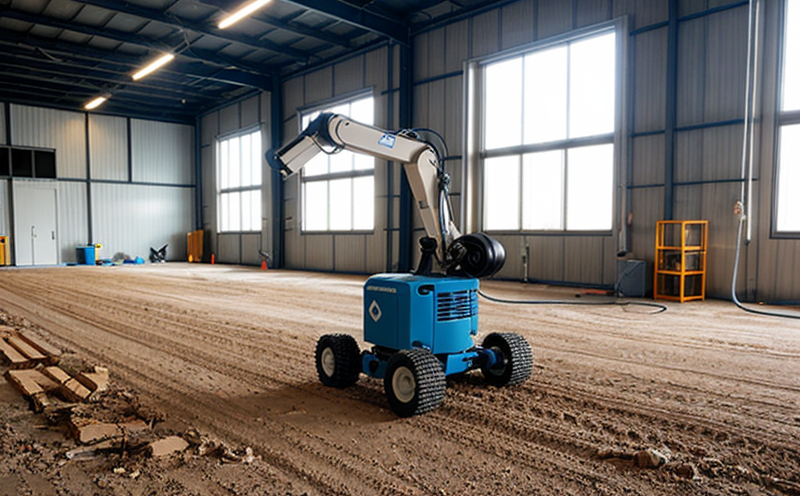IEC 60068-2-27 Shock Resistance Testing for Robotic Systems
The IEC 60068-2-27 standard is widely recognized in the robotics and artificial intelligence (AI) sector as a key method to ensure that robotic systems are capable of withstanding shock loads. This testing is critical because it helps manufacturers identify potential weaknesses in their designs, ensuring robustness and reliability under real-world conditions.
Robotic systems operate in environments where they may encounter sudden changes in force or impact due to external factors such as collisions, rough terrain, or human interaction. To meet industry standards and regulatory requirements, these systems need to be tested for their ability to withstand shock loads without compromising performance or safety. The IEC 60068-2-27 test simulates real-world conditions by applying controlled shock pulses to the robotic system, measuring its response, and evaluating whether it meets specified performance criteria.
The testing process involves several key steps. First, the robotic system is prepared according to industry best practices, ensuring that all components are assembled correctly and aligned with the test objectives. Next, the test setup includes a vibration table or similar apparatus capable of generating controlled shock pulses. The intensity and duration of these shocks are carefully calibrated based on the specific requirements outlined in IEC 60068-2-27.
During testing, the robotic system is subjected to multiple cycles of shock loading, typically ranging from low to high levels. Sensors and data acquisition systems continuously monitor the system's response throughout each cycle, collecting detailed information on displacement, acceleration, and other relevant parameters. After completing all test iterations, this data is analyzed to determine whether the robotic system has passed or failed based on predefined acceptance criteria.
One of the most important aspects of IEC 60068-2-27 shock resistance testing is its focus on real-world applicability. By simulating specific types of shocks that robots might encounter, such as those from falling objects or accidental impacts during operation, testers can assess how well a given design will perform in challenging situations. This approach ensures that manufacturers develop products that are not only technically sound but also safe and reliable when deployed.
Another critical component of this testing is the use of appropriate instrumentation to measure both the input shock waveforms and the resulting responses from the robotic system. High-precision accelerometers, strain gauges, and other sensors play crucial roles in capturing accurate data during each test cycle. These measurements allow engineers to pinpoint areas where improvements could be made to enhance durability or reduce vulnerability to damage.
Passing IEC 60068-2-27 shock resistance testing provides several benefits for manufacturers and end users alike. For one thing, it demonstrates compliance with international standards, which is often required by regulatory bodies when approving new robotic systems for commercial use. Additionally, successful completion of these tests helps build trust among customers who want assurance that their purchased robots will function reliably over time without failing unexpectedly.
In summary, IEC 60068-2-27 shock resistance testing plays an essential role in ensuring the quality and reliability of robotic systems by simulating real-world conditions through controlled shock pulses. Through rigorous preparation, execution, analysis, and reporting, this process helps identify potential issues early on while providing valuable insights into design improvements that can enhance overall performance.
Applied Standards
| Standard Name | Description |
|---|---|
| IEC 60068-2-27 | This part of IEC 60068 specifies the procedure for determining the shock resistance characteristics of electrical, electronic and mechanical equipment. It covers tests using random vibration and step shock methods. |
| ISO/IEC Guide 51 | An international standard providing guidance on the application of environmental test standards to products or systems. |
| ASTM E368 | Test method for measuring the impact resistance of electronic equipment. |
The IEC 60068-2-27 standard is particularly relevant to robotic systems because it addresses specific challenges faced by these devices in terms of shock tolerance. By adhering to this international guideline, manufacturers ensure that their products meet stringent quality requirements and perform consistently across various environments.
Quality and Reliability Assurance
- Data acquisition and analysis using sophisticated instrumentation such as accelerometers and strain gauges.
- Controlled environmental conditions to simulate real-world shock scenarios.
- Repeatable test procedures for consistent results across multiple iterations.
- Comprehensive documentation of all testing parameters, including input waveforms and measured responses.
To maintain high standards of quality and reliability in robotic systems, it is essential that manufacturers implement robust quality assurance measures throughout the entire product lifecycle. IEC 60068-2-27 shock resistance testing plays a vital role within this framework by providing a standardized method for evaluating how well a particular design can withstand shocks without sustaining permanent damage.
Competitive Advantage and Market Impact
Adhering to IEC 60068-2-27 shock resistance testing offers several advantages that contribute significantly to competitive positioning in the robotics market. Firstly, it enhances product safety by identifying potential weaknesses early in development cycles, allowing for timely corrections before mass production begins. Secondly, successful completion of these tests helps build customer confidence, fostering long-term relationships with satisfied clients who know their investments are protected against unforeseen failures.
From a regulatory perspective, compliance with international standards like IEC 60068-2-27 is increasingly becoming mandatory for many robotic systems intended for deployment in public spaces or industrial settings. This means that non-compliance risks costly delays and potential bans from entering certain markets. By staying ahead of these trends through thorough testing processes, companies position themselves as leaders in innovation and best practices.
In conclusion, embracing IEC 60068-2-27 shock resistance testing not only strengthens product quality but also opens up opportunities for growth within competitive landscapes characterized by stringent safety regulations and growing demand for reliable robotic technologies.





